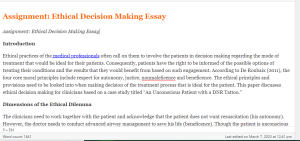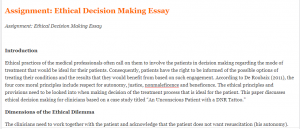Assignment: Ethical Decision Making Essay
Assignment Ethical Decision Making Essay
Introduction
Ethical practices of the medical professionals often call on them to involve the patients in decision making regarding the mode of treatment that would be ideal for their patients. Consequently, patients have the right to be informed of the possible options of treating their conditions and the results that they would benefit from based on such engagement. According to De Roubaix (2011), the four core moral principles include respect for autonomy, justice, nonmaleficence and beneficence. The ethical principles and provisions need to be looked into when making decision of the treatment process that is ideal for the patient. This paper discusses ethical decision making for clinicians based on a case study titled “An Unconscious Patient with a DNR Tattoo.”
Dimensions of the Ethical Dilemma
The clinicians need to work together with the patient and acknowledge that the patient does not want resuscitation (his autonomy). However, the doctor needs to conduct advanced airway management to save his life (beneficence). Though the patient is unconscious and does not consent to the treatment chosen, intravenous fluid resuscitation and issuance of empirical antibiotics are granted against his wish (nonmaleficence).
The critical dimension of ethical dilemma is derived from the need to respect the advance directive that has been issued by a patient regarding the type of care that needs to be advanced to him or her. An advanced directive is a legal document that medical professionals have to honour. Any adult has the right of coming up with his or her advance directive to serve the purpose of guiding orders for end of life including the appointment of his or her surrogate. Failure to honour the ethical directive by the patient would often call for the ethics committee to review the decisions of the medical professional and where necessary reprimand them for not acknowledging the wishes and rights of the patient. The other dimension of ethical decision making is adherence to HIPAA regulations and patient confidentiality.

Potential Organizational Policies
The ethical policies of a health institution are an ideal point of reference whenever a moral dilemma faces healthcare professionals.

The policies establish an ethical review committee within the facilities. The medics have the role of reporting their ethical dilemmas to the committee and await the directive of the committee before proceeding with their decision. The ethical policy provision for justice, the balance of risk and benefits and patient consent are some of the measures that clinicians need to consider in when referring to the moral principles. However, where the wish of the patient is contrary to the procedure that the clinicians would want to issue, the contrary opinion of the patient has to be legal and abiding by the ethical principles of clinical practice.
Click here to ORDER an A++ paper from our MASTERS and DOCTORATE WRITERS: Assignment: Ethical Decision Making Essay
Four core health care ethical principles and the process of ethical decision making
Autonomy
The respect for autonomy affirms that any patient has the right of deciding on the type or nature of treatment that he or she wants. The ethical principles are the basis upon which informed consent is revered within the health settings. The healthcare settings need to eliminate the factors that would either coerce or lead the patient to decide their free and voluntary acts (De Roubaix, 2011). The principle also calls upon the medics to issue all the information regarding the possible treatment methods and the side effects that could result to the patient when either of the treatment options is decided upon by the patient. However, based on the case study, the patient has been brought into the hospital when he is unconscious. Therefore, he is not in a position to comprehend the treatment methods that would not be ideal for him nor can be taken and sign an informed consent for the advanced airway management to be conducted by the medics. Such would lead to the consideration of the principle of justice
Justice
The principle of justice establishes that all patients have a right to care. There is a need to provide healthcare services equally to all despite their economic, racial or cultural backgrounds (De Roubaix, 2011). Both the conscious and the unconscious patients, therefore, have the right to access quality medical care that would be of benefit to their developmental processes. The medics have an ethical duty to serve the patient despite him being unconscious when taking the principle to the context of the case study. Admission of the patient, diagnosing the issue and owing the willingness to assist in the treatment of the patient is ethical conduct on the part of the patients, which would then serve to facilitate his access to medical care.
Beneficence
The third principle is that of beneficence. The medical professions have to act in a manner that would bring out positive outcomes to the medical condition of the patients. Therefore, the action of the medical professionals, despite the choices that the patient makes, should be aimed at improving the overall patient outcome and contribute to making the patient feel better (De Roubaix, 2011). This principle has been applied in the case study. Despite the patient not being capable of finding informed consent for the advanced airway management, it will be critical to access, the issuance of intravenous fluid resuscitation and issuance of empirical antibiotics when waiting for the result from the ethics review committee is part of the ethical considerations of the doctors and nurses handling the case.
Nonmaleficence
The principle of nonmaleficence has also been utilized by the physicians handling the case of the client. The policy provides that medics should act in a manner that is of benefit to the patient and eliminate the incidences of harm that could be posed to the patient in the course of the treatment (De Roubaix, 2011). Taking up the issue as an emergency and finding out the ideal procedures, committing the patient to treatment as sending the patient case for review is the commitment of the patient to the principle of nonmaleficence.
The assistance to the clinical staff, based on the information on the case study, is to recognize that tattoos do not meet the threshold that is needed for advance directives. Therefore, it will be ideal for the clinicians to proceed with the emergency treatment that gears towards the saving of the life of the patient. Maintaining the treatment methods or de-escalation of the treatment procedures can be done when written documentation on the preferred patient model of care or patient consent can be enforced when the patient is out of danger. Such would mean that the clinicians would need to impose the principle of beneficence while at the emergency room.
Assignment: Ethical Decision Making Essay Conclusion
In the healthcare setting, it is essential to recognize that the preferences of an end of care and tattoos would often change based on the changing preferences of the patients. Therefore, only where there is legal and written documentation that expressly state that a given form of care is not ideal for the patient, the clinicians must impose the principles of nonmaleficence, beneficence and justice in the issuance of care and medication to the patient. The tattoos tend not to offer strong medication on what the clinicians would need not to do. While the clinicians have to respect the wishes of their patients, it is essential to receive proper guidance to the clinicians. Where the instructions are vague as is the case of the tattoo, it would be ideal to ignore such until sufficient information is existent. The term “DO NOT RESUSCITATE” does not specify what or what not to do. Within the medical profession, clinicians may not guess informed decision making of the patient.
Write a 1,250-1,500 word paper in which you explore decision making methods that can be used to resolve an ethical dilemma using the scenario provided in the assigned reading, \”An Unconscious Patient With a DNR Tattoo.\” Describe how to use the principles of ethical decision making (reviewed in this topic) to help resolve this ethical dilemma. Address the scenario to generate your conclusions about how you would proceed.
What are the dimensions of the ethical dilemma?
What are the potential organizational policies to which you will refer?
Apply the four core health care ethical principles and the process of ethical decision making in formulating your assistance to the clinical staff.
Prepare this assignment according to the guidelines found in the APA Style Guide, located in the Student Success Center. An abstract is not required.
Lopes Write Policy
For assignments that need to be submitted to Lopes Write, please be sure you have received your report and Similarity Index (SI) percentage BEFORE you do a “final submit” to me.
Once you have received your report, please review it. This report will show you grammatical, punctuation, and spelling errors that can easily be fixed. Take the extra few minutes to review instead of getting counted off for these mistakes.
Review your similarities. Did you forget to cite something? Did you not paraphrase well enough? Is your paper made up of someone else’s thoughts more than your own?
Visit the Writing Center in the Student Success Center, under the Resources tab in LoudCloud for tips on improving your paper and SI score.
Late Policy
The university’s policy on late assignments is 10% penalty PER DAY LATE. This also applies to late DQ replies.
Please communicate with me if you anticipate having to submit an assignment late. I am happy to be flexible, with advance notice. We may be able to work out an extension based on extenuating circumstances.
If you do not communicate with me before submitting an assignment late, the GCU late policy will be in effect.
I do not accept assignments that are two or more weeks late unless we have worked out an extension.
As per policy, no assignments are accepted after the last day of class. Any assignment submitted after midnight on the last day of class will not be accepted for grading.
Communication
Communication is so very important. There are multiple ways to communicate with me:
Questions to Instructor Forum: This is a great place to ask course content or assignment questions. If you have a question, there is a good chance one of your peers does as well. This is a public forum for the class.
Individual Forum: This is a private forum to ask me questions or send me messages. This will be checked at least once every 24 hours.
Important information for writing discussion questions and participation
Welcome to class
Hello class and welcome to the class and I will be your instructor for this course. This is a -week course and requires a lot of time commitment, organization, and a high level of dedication. Please use the class syllabus to guide you through all the assignments required for the course. I have also attached the classroom policies to this announcement to know your expectations for this course. Please review this document carefully and ask me any questions if you do. You could email me at any time or send me a message via the “message” icon in halo if you need to contact me. I check my email regularly, so you should get a response within 24 hours. If you have not heard from me within 24 hours and need to contact me urgently, please send a follow up text to
I strongly encourage that you do not wait until the very last minute to complete your assignments. Your assignments in weeks 4 and 5 require early planning as you would need to present a teaching plan and interview a community health provider. I advise you look at the requirements for these assignments at the beginning of the course and plan accordingly. I have posted the YouTube link that explains all the class assignments in detail. It is required that you watch this 32-minute video as the assignments from week 3 through 5 require that you follow the instructions to the letter to succeed. Failure to complete these assignments according to instructions might lead to a zero. After watching the video, please schedule a one-on-one with me to discuss your topic for your project by the second week of class. Use this link to schedule a 15-minute session. Please, call me at the time of your appointment on my number. Please note that I will NOT call you.
Please, be advised I do NOT accept any assignments by email. If you are having technical issues with uploading an assignment, contact the technical department and inform me of the issue. If you have any issues that would prevent you from getting your assignments to me by the deadline, please inform me to request a possible extension. Note that working fulltime or overtime is no excuse for late assignments. There is a 5%-point deduction for every day your assignment is late. This only applies to approved extensions. Late assignments will not be accepted.
If you think you would be needing accommodations due to any reasons, please contact the appropriate department to request accommodations.
Plagiarism is highly prohibited. Please ensure you are citing your sources correctly using APA 7th edition. All assignments including discussion posts should be formatted in APA with the appropriate spacing, font, margin, and indents. Any papers not well formatted would be returned back to you, hence, I advise you review APA formatting style. I have attached a sample paper in APA format and will also post sample discussion responses in subsequent announcements.
Your initial discussion post should be a minimum of 200 words and response posts should be a minimum of 150 words. Be advised that I grade based on quality and not necessarily the number of words you post. A minimum of TWO references should be used for your initial post. For your response post, you do not need references as personal experiences would count as response posts. If you however cite anything from the literature for your response post, it is required that you cite your reference. You should include a minimum of THREE references for papers in this course. Please note that references should be no more than 5 years old except recommended as a resource for the class. Furthermore, for each discussion board question, you need ONE initial substantive response and TWO substantive responses to either your classmates or your instructor for a total of THREE responses. There are TWO discussion questions each week, hence, you need a total minimum of SIX discussion posts for each week. I usually post a discussion question each week. You could also respond to these as it would count towards your required SIX discussion posts for the week.
I understand this is a lot of information to cover in 5 weeks, however, the Bible says in Philippians 4:13 that we can do all things through Christ that strengthens us. Even in times like this, we are encouraged by God’s word that we have that ability in us to succeed with His strength. I pray that each and every one of you receives strength for this course and life generally as we navigate through this pandemic that is shaking our world today. Relax and enjoy the course!
Hi Class,
Please read through the following information on writing a Discussion question response and participation posts.
Contact me if you have any questions.
Important information on Writing a Discussion Question
- Your response needs to be a minimum of 150 words (not including your list of references)
- There needs to be at least TWO references with ONE being a peer reviewed professional journal article.
- Include in-text citations in your response
- Do not include quotes—instead summarize and paraphrase the information
- Follow APA-7th edition
- Points will be deducted if the above is not followed
Participation –replies to your classmates or instructor
- A minimum of 6 responses per week, on at least 3 days of the week.
- Each response needs at least ONE reference with citations—best if it is a peer reviewed journal article
- Each response needs to be at least 75 words in length (does not include your list of references)
- Responses need to be substantive by bringing information to the discussion or further enhance the discussion. Responses of “I agree” or “great post” does not count for the word count.
- Follow APA 7th edition
- Points will be deducted if the above is not followed
- Remember to use and follow APA-7th edition for all weekly assignments, discussion questions, and participation points.
- Here are some helpful links
- Student paper example
- Citing Sources
- The Writing Center is a great resource

